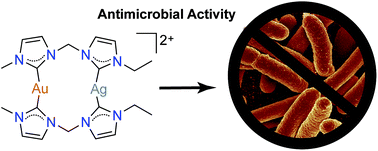A post-synthetic modification and metallation procedure has been used to prepare a family of heterobimetallic Au(I)–Ag(I) and Au(I)–Hg(II) complexes featuring either symmetrical or asymmetrical bis-N-heterocyclic carbene ligands with methylene or ethylene linker groups. This synthetic approach is versatile and allows for the synthesis of heterobimetallic complexes bearing asymmetrical ligands that differ in the nature of the NHC wingtip substituents (dimethyl, diethyl or ethyl-methyl) and for the selective placement of the different metal ions. The synthesised complexes were characterised using 1H and 13C NMR spectroscopy and high resolution mass spectrometry (HR-MS) and in the case of complexes 4a, 5b and 8b by X-ray crystallography. The complexes of the methylene linked bridging ligands display conformational isomerism in solution and the conformations adopted by selected compounds were examined using variable temperature (VT) 1H NMR studies. The antibacterial properties of the heterobimetallic Au(I)–Ag(I) complexes in addition to the corresponding homobimetallic Ag(I)2, Au(I)2 complexes were evaluated against clinically relevant Gram-positive and Gram-negative bacterial strains. The homobimetallic Au(I)2 complex and precursor pro-ligand displayed no antibacterial activity up to 256 μg mL−1, whereas the homobimetallic Ag(I)2 was active against all Gram-positive and Gram-negative bacterial strains tested (MIC = 8–32 μg mL−1). Interestingly, both Au(I)–Ag(I) heterobimetallic complexes displayed similar broad-spectrum activity (MIC = 4–32 μg mL−1) to the Ag(I)2 homobimetallic complex.

